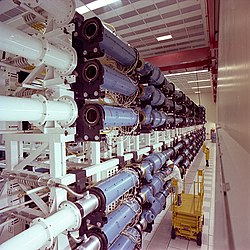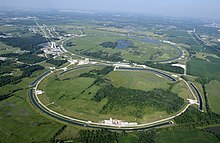Big science
An editor has nominated this article for deletion. You are welcome to participate in the deletion discussion, which will decide whether or not to retain it. |
- This article is about the term. For the album, see Big Science (album).

Big Science is a term used by scientists and historians of science to describe a series of changes in science which occurred in industrial nations during and after World War II, when the making of science shifted from individual or small group efforts, or Small Science, to relying on large-scale heavily funded projects. Small science is still relevant today as theoretical results by individual authors may have a significant impact, but very often the empirical verification requires experiments using constructions, such as the Large Hadron Collider costing between $5 and $10 billion.
Development
While science and technology have always been important to and driven by warfare, the increase in military funding of science following the second World War was on a scale wholly unprecedented. World War II has often been called "the physicists' war" for the role that those scientists played in the development of new weapons and tools, notably the proximity fuze, radar, and the atomic bomb. The bulk of these last two activities took place in a new form of research facility: the government-sponsored laboratory, employing thousands of technicians and scientists, managed by universities (in this case, the University of California and the Massachusetts Institute of Technology).
In the shadow of the first atomic weapons, the importance of a strong scientific research establishment was apparent to any country wishing to play a major role in international politics. After the success of the Manhattan Project, governments became the chief patron of science, and the character of the scientific establishment underwent several key changes. This was especially marked in the United States and the Soviet Union during the Cold War, but also to a lesser extent in many other countries.
Definitions
"Big Science" usually implies one or more of these specific characteristics:
- Big budgets: No longer required to rely on philanthropy or industry, scientists were able to use budgets on an unprecedented scale for basic research.
- Big staffs: Similarly, the number of practitioners of science on any one project grew as well, creating difficulty, and often controversy, in the assignment of credit for scientific discoveries (the Nobel Prize system, for example, allows awarding only three individuals in any one topic per year, based on a 19th-century model of the scientific enterprise).
- Big machines: Ernest Lawrence's cyclotron at his Radiation Laboratory in particular ushered in an era of massive machines (requiring massive staffs and budgets) as the tools of basic scientific research. The use of many machines, such as the many sequencers used during the Human Genome Project, might also fall under this definition..

- Big laboratories: Because of the increase in cost to do basic science (with the increase of large machines), centralization of scientific research in large laboratories (such as Lawrence Berkeley National Laboratory or CERN) has become a cost-effective strategy, though questions over facility access have become prevalent.
Towards the end of the 20th century, not only projects in basic physics and astronomy, but also in life sciences became big sciences, such as the massive project involved in the sequencing of the human genome. The heavy investment of government and industrial interests into academic science has also blurred the line between public and private research, where entire academic departments, even at public universities, are often financed by private companies. Not all Big Science is related to the military concerns which were at its origins.
Criticism
The era of Big Science has provoked criticism that it undermines the basic principles of the scientific method.[citation needed] Results of experiments which require massive and unique machines like particle accelerators are often difficult to verify.[citation needed] Access to scientific facilities is often limited to those who are already accomplished, leading to charges of elitism.[citation needed] And increased government funding has often meant increased military funding, which some claim[who?] subverts the Enlightenment-era ideal of science as a pure quest for knowledge.
Many scientists also complain that the requirement for increased funding makes a large part of the scientific activity filling out grant requests and other budgetary bureaucratic activity, and the intense connections between academic, governmental, and industrial interests have raised the question of whether scientists can be completely objective when their research contradicts the interests and intentions of their benefactors.
Historiography of Big Science
The popularization of the term "Big Science" is usually attributed to an article by Alvin M. Weinberg, then director of Oak Ridge National Laboratory, published in Science in 1961.[1] Weinberg compared the large-scale enterprise of science in the 20th century to the wonders of earlier civilization (the pyramids, the palace of Versailles):
- When history looks at the 20th century, she will see science and technology as its theme; she will find in the monuments of Big Science—the huge rockets, the high-energy accelerators, the high-flux research reactors—symbols of our time just as surely as she finds in Notre Dame a symbol of the Middle Ages. ... We build our monuments in the name of scientific truth, they built theirs in the name of religious truth; we use our Big Science to add to our country's prestige, they used their churches for their cities' prestige; we build to placate what ex-President Eisenhower suggested could become a dominant scientific caste, they built to please the priests of Isis and Osiris.
Weinberg's article addressed criticisms of the way in which the era of Big Science could negatively affect science — such as astronomer Fred Hoyle's contention that excessive money for science would only make science fat and lazy — and encouraged, in the end, limiting Big Science only to the national laboratory system and preventing its incursion into the university system.
Since Weinberg's article there have been many historical and sociological studies on the effects of Big Science both in and out of the laboratory.[citation needed] Many historians have postulated many "pre-cursors" to Big Science in earlier times: the Uraniborg of Tycho Brahe (in which massive astronomical instruments were made, often with little practical purpose)[citation needed] and the large cryogenics laboratory established by Heike Kamerlingh Onnes in 1904 have been cited as early examples of Big Science.[2]
Notes
- ^ Alvin M. Weinberg, "Impact of Large-Scale Science on the United States" Science 134, no. 3473 (21 July 1961), p. 161-164.
- ^ For references to Tycho's work as Big Science, see John Robert Christianson, On Tycho's Island: Tycho Brahe and His Assistants, 1570-1601 (New York, Cambridge University Press: 2000). For references to Kamerlingh Onnes as Big Science, see "Physics at Low Temperatures" in Helge Kragh, Quantum Generations: A History of Physics in the Twentieth Century (Princeton, NJ: Princeton University Press, 1999): 74-86.
References
Wiener, Norbert (1988). The Human Use of Human Beings. Da Capo Press. ISBN 0306803208.
